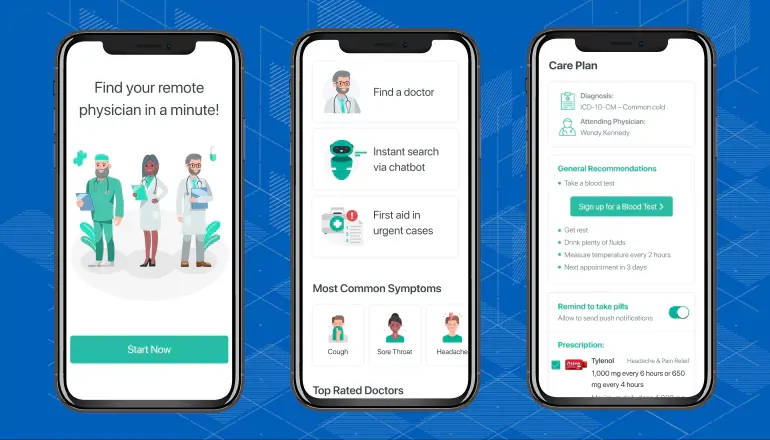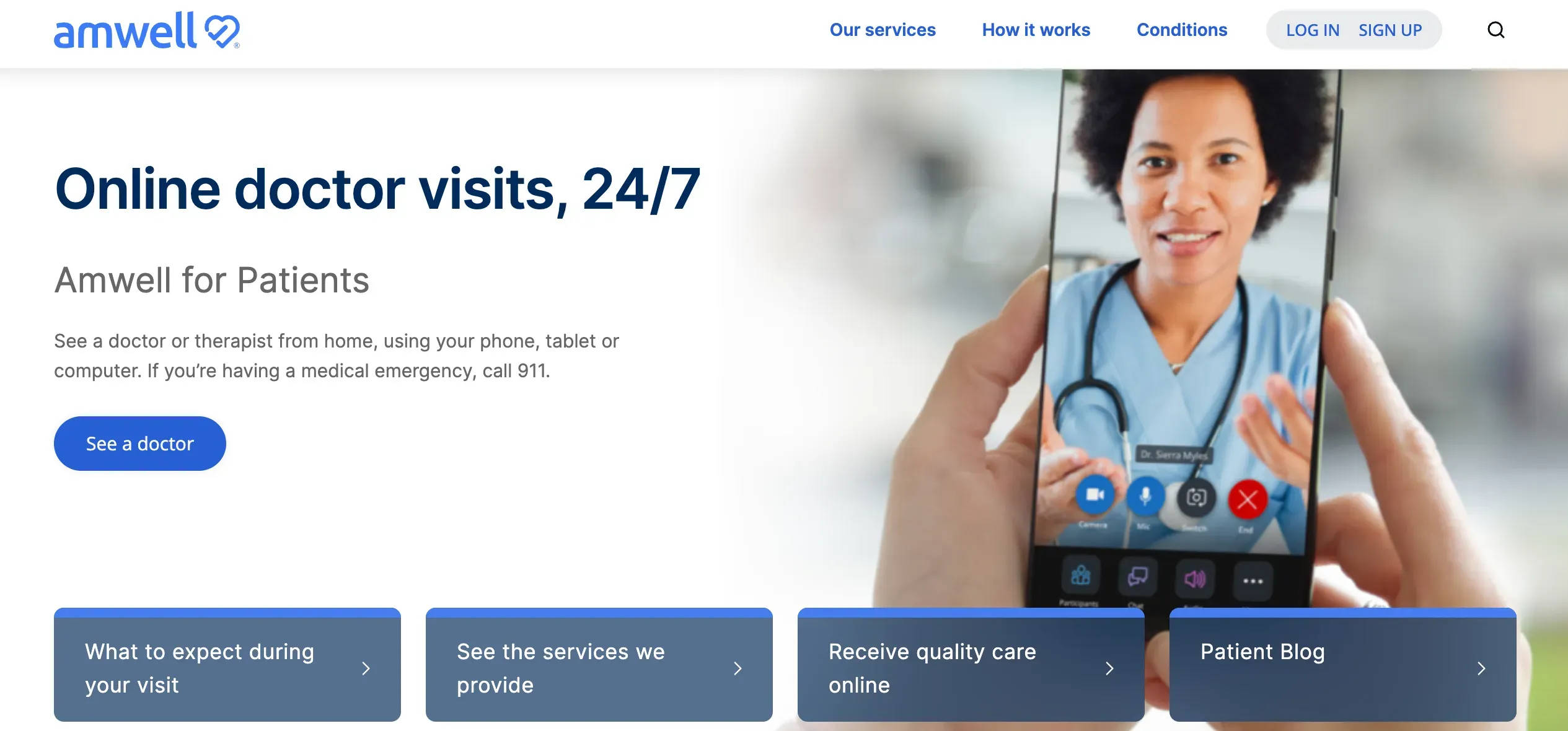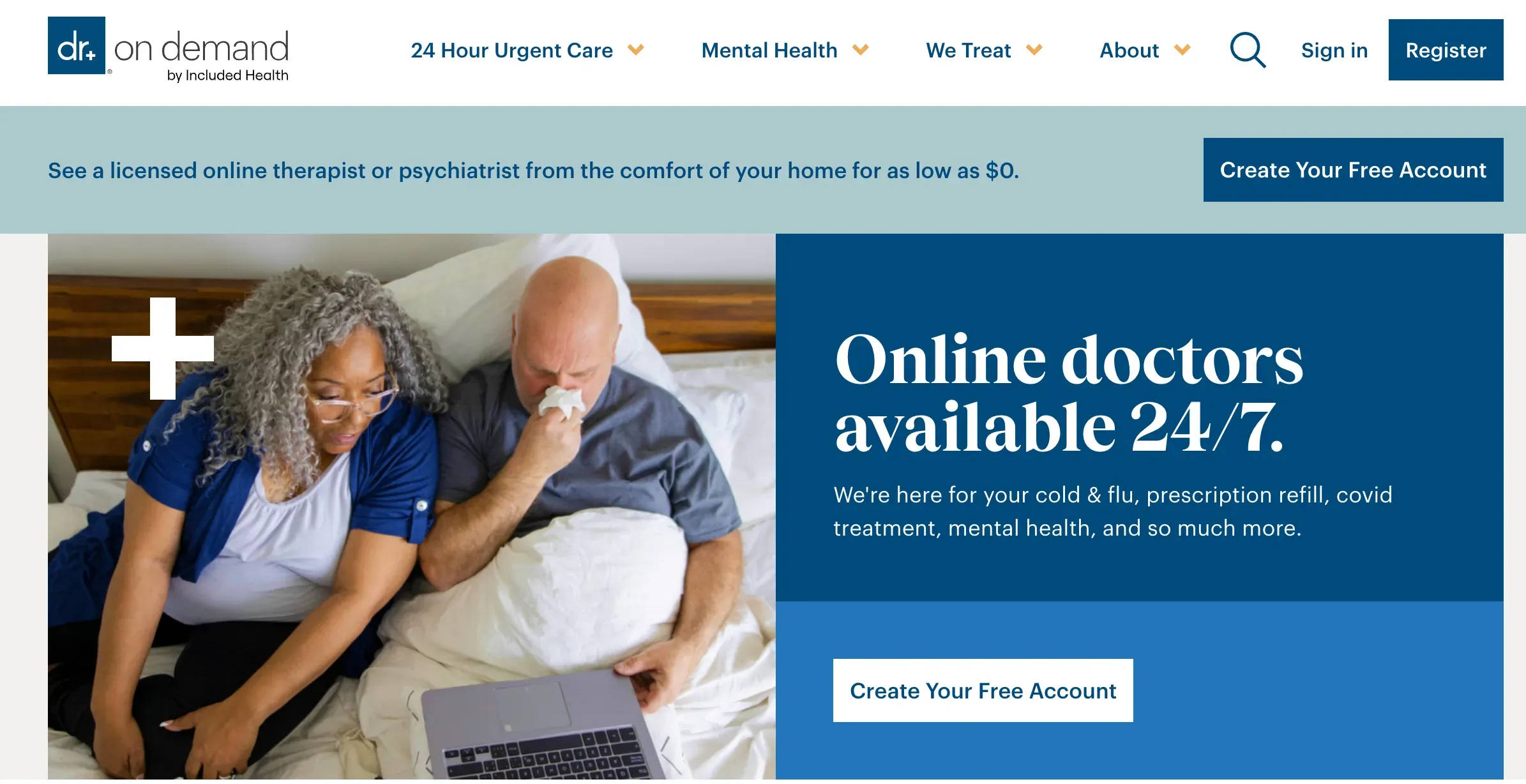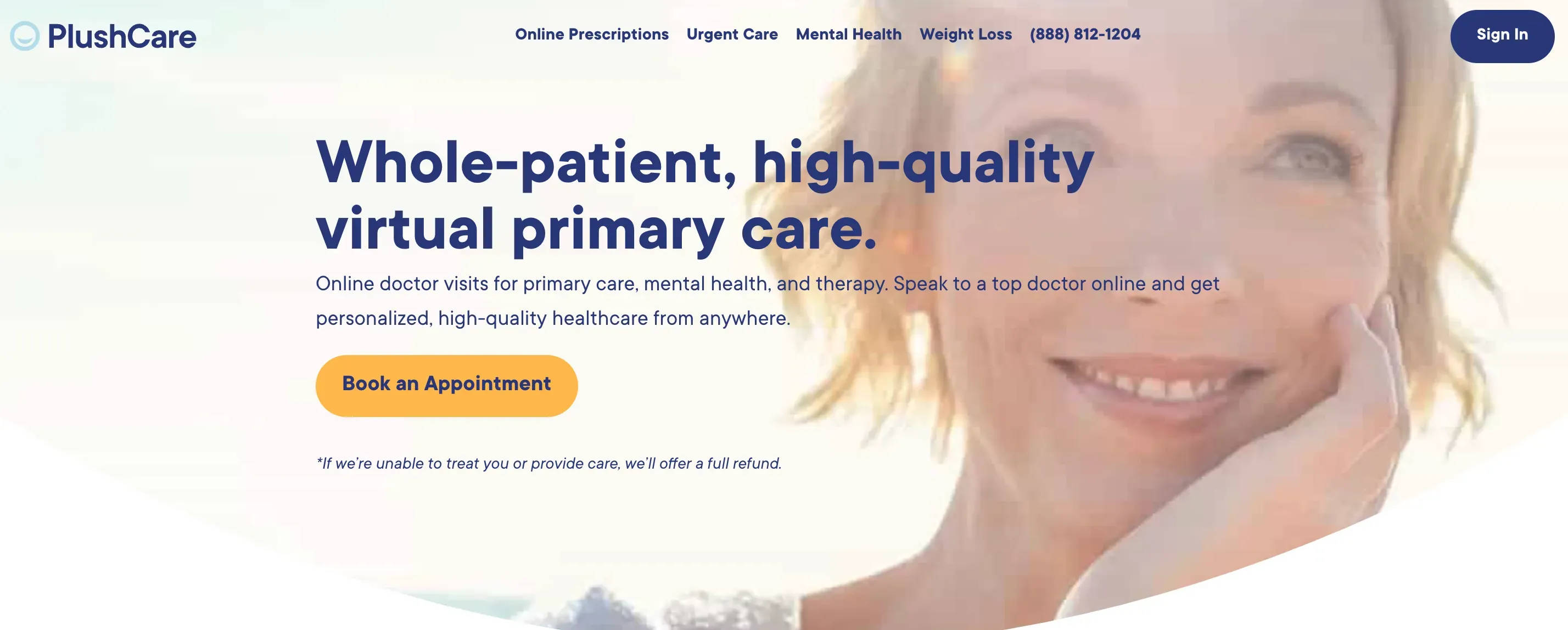- What is Telehealth?
- What is a Telehealth app?
- What is Telehealth counseling?
- Popular Telehealth Apps
- Services provided by Telehealth apps
- Features of Telehealth Apps
- How to build a Telehealth app with AppsRhino?
- Conclusion
Table of Contents
Telehealth at a Glance: An Answer to all your Questions!

In today's fast-paced world, technology has revolutionized how we live, work, and seek medical care. As we grapple with the challenges posed by the global pandemic and the growing demand for accessible healthcare, Telehealth has emerged as a shining beacon of hope, transforming the landscape of healthcare delivery.
Imagine a world where medical consultations are no longer bound by the constraints of physical proximity, where individuals can access expert healthcare advice, diagnosis, and treatment from their homes, regardless of their location.
Telehealth, the fusion of technology and healthcare, empowers patients and healthcare providers alike, bridging the gap between them through the power of digital connectivity. Let us learn more about Telehealth in this blog!
What is Telehealth?

Telehealth is not just a convenience; it's a lifeline for those facing physical disabilities, transportation challenges, or limited mobility. With a simple video call, patients can connect with doctors, nurses, and specialists, sharing their symptoms, concerns, and medical history, allowing for accurate diagnosis and personalized treatment plans.
Through telehealth platforms, individuals can access a wide range of healthcare services, including mental health counseling, chronic disease management, medication consultations, and even urgent care for minor ailments.
What is a Telehealth app?
A telehealth app is like a magical portal that connects patients and healthcare providers seamlessly, transcending the boundaries of time and space. With a few taps on your device, a virtual realm of healthcare opens up, ready to conveniently cater to your medical needs.
With a telehealth app, you can connect with healthcare professionals from your home. A telehealth app ensures that quality medical care is always available to you at the earliest.
Telehealth apps have witnessed significant growth and adoption in recent years. They are driven by technological advancements and the increasing demand for convenient healthcare solutions.
A report published by Mordor Intelligence revealed that the global telehealth market share was valued at approximately $45 billion in 2019. It is projected to reach over $191 billion by 2025, exhibiting a CAGR of around 25% during the forecast period.
Patients have shown a positive response to telehealth apps. A survey held by the Harris Poll revealed that 66% of U.S. adults are willing to use Telehealth, with convenience and reduced wait times being the primary drivers of adoption.
Studies have also shown high patient satisfaction rates with telehealth apps. Research published in JAMA Network Open found that telehealth visits were associated with a patient satisfaction score of 87.6 out of 100.
As technology advances and healthcare systems evolve, telehealth apps are poised to play a pivotal role in providing accessible and convenient healthcare services to individuals worldwide.
Suggested Reading:
What is Telehealth counseling?

Telehealth counseling, also known as teletherapy or online counseling, refers to providing mental health counseling and therapy services through remote communication technologies.
It involves using telecommunication platforms such as video calls, audio chats, or instant messaging to facilitate therapeutic sessions between mental health professionals and their clients.
Telehealth counseling offers individuals the opportunity to receive mental health support and therapy from the comfort of their own homes or any convenient location.
Through secure and confidential virtual platforms, clients can connect with licensed therapists, psychologists, or counselors to address various mental health concerns, including anxiety, depression, stress, trauma, relationship issues, and more.
The process of telehealth counseling is similar to traditional in-person counseling sessions. Clients engage in therapeutic discussions with their mental health providers, exploring their emotions, thoughts, and experiences.
Telehealth platforms often include video features, allowing for face-to-face interactions and non-verbal communication cues, which can enhance the therapeutic connection between the client and the therapist.
Telehealth counseling offers several benefits. It provides increased accessibility to mental health services, particularly for individuals who may face barriers such as geographic distance, limited mobility, or transportation challenges.
It also allows individuals to seek counseling in a more flexible and convenient manner, accommodating busy schedules or preferences for remote therapy.
Additionally, telehealth counseling has become particularly relevant during times of crisis, when in-person interactions may be limited or restricted. It offers a safe alternative for individuals to receive the health support they need while adhering to physical distancing guidelines.
Popular Telehealth Apps
Telehealth has experienced significant growth in recent years, leading to the emergence of various popular telehealth apps that have revolutionized the way healthcare is accessed and delivered. Here are some renowned telehealth apps that have garnered widespread popularity:
Amwell (formerly American Well)

Amwell is a widely recognized telehealth app that offers virtual consultations with certified doctors, therapists, and specialists. It provides 24/7 access to medical professionals, allowing users to address non-emergency medical concerns conveniently.
Amwell's user-friendly interface and broad range of services have made it a popular choice for many seeking telehealth consultations.
Teladoc

Teladoc is a renowned telehealth platform that connects users with licensed healthcare providers, including doctors, therapists, and dermatologists.
Users can access Teladoc's services via their mobile app or website, enabling convenient and on-demand virtual consultations for various non-emergency healthcare needs.
Teladoc also offers options for prescription delivery, making it a comprehensive telehealth solution.
Doctor On Demand

Doctor On Demand is a popular telehealth app that offers video visits with licensed physicians, psychiatrists, and psychologists. The app provides various services, including general medical consultations, mental health support, and chronic disease management.
Doctor On Demand aims to deliver high-quality healthcare through its user-friendly interface and emphasis on patient convenience.
MDLIVE

MDLIVE is a telehealth platform that connects users with healthcare professionals for virtual visits.
Through the MDLIVE app, users can access medical consultations, mental health services, and even dermatology consultations.
The app allows patients to schedule appointments, select preferred providers, and securely share medical information, ensuring a seamless telehealth experience.
PlushCare

PlushCare is a telehealth app that facilitates virtual consultations with trusted doctors. It offers on-demand appointments and addresses various healthcare needs, from general medical advice to chronic condition management.
PlushCare provides personalized and patient-centered care through its intuitive app interface and dedicated team of healthcare providers.
Services provided by Telehealth apps
Offer a wide range of healthcare services to deliver convenient and accessible care to individuals. Here are some common services telehealth apps offer:
Virtual Consultations

Telehealth apps enable virtual consultations with healthcare professionals. Patients can discuss their symptoms, receive medical advice, and get a diagnosis from licensed doctors, nurses, and specialists. These consultations typically take place through video calls or audio chats.
General Medical Care
Telehealth apps offer general medical care services, allowing patients to seek assistance for common ailments such as cold and flu symptoms, allergies, minor injuries, infections, and other non-emergency conditions.
Users can receive treatment recommendations, prescriptions, and follow-up care remotely.
Mental Health Support
Many telehealth apps include mental health services, providing individuals with access to therapists, psychologists, and psychiatrists. Users can receive counseling, therapy sessions, and treatment for mental health conditions.
Chronic Disease Management
Telehealth apps facilitate the remote management of chronic conditions such as diabetes, hypertension, asthma, and arthritis.
Patients can receive guidance on medication management, lifestyle modifications, and regular check-ins with healthcare professionals to monitor their health status and make necessary adjustments to their treatment plans.
Prescription Refills

Telehealth apps often allow users to request prescription refills for ongoing medications. Through virtual consultations, doctors can review patients' medical histories, assess their medication needs, and provide electronic prescriptions to be filled at the pharmacy of their choice.
Dermatology Consultations
Some telehealth apps offer specialized services for dermatology consultations. Users can share images or descriptions of skin conditions and receive evaluations, diagnoses, and treatment recommendations from dermatologists, including prescriptions for topical medications if needed.
Health and Wellness Education
Telehealth apps may provide educational resources on various health topics, empowering users with information to manage their well-being effectively.
These resources can include articles, videos, and personalized health tips based on users' profiles and medical histories.
Features of Telehealth Apps
Telehealth apps encompass a range of features that contribute to their effectiveness and usability in providing remote healthcare services. Here are some important features of telehealth apps:
Secure Communication
Telehealth apps prioritize secure communication channels to ensure the privacy and confidentiality of patient information.
End-to-end encryption and secure data storage mechanisms safeguard sensitive medical data exchanged during virtual consultations, maintaining patient trust and adhering to regulatory requirements.
Video and Audio Conferencing

The ability to conduct video and audio calls within the app is a crucial feature of telehealth platforms.
High-quality video and audio capabilities enable real-time interactions between healthcare providers and patients, facilitating a more personalized and engaging virtual consultation experience.
Electronic Health Records (EHR) Integration
Integration with electronic health record systems enables seamless access to patients' medical histories, lab results, and previous diagnoses.
This feature empowers healthcare providers to make informed decisions during telehealth consultations and ensures continuity of care by maintaining a comprehensive patient record.
Prescriptions and Referrals
Telehealth apps may include the ability to issue electronic prescriptions, making it convenient for patients to receive necessary medications remotely.
Additionally, the app may facilitate referrals to specialists or diagnostic facilities, streamlining the process of coordinating further care if required.
Secure File Sharing
Telehealth apps often provide a secure file-sharing feature, allowing patients to upload documents such as lab reports, medical images, or insurance information.
It enables healthcare providers to review relevant documents during the consultation, enhancing the accuracy of diagnoses and treatment recommendations.
Appointment Scheduling

Telehealth apps often include appointment scheduling functionality, allowing users to book virtual visits conveniently.
Users can view available time slots, select preferred healthcare providers, and manage their appointments, streamlining the process of accessing remote healthcare services.
In-App Messaging
Real-time messaging functionality allows patients and healthcare providers to communicate securely within the app. This feature enables users to ask follow-up questions, seek clarification on treatment plans, and receive ongoing support and guidance.
Multi-platform Accessibility
Telehealth apps that support multiple platforms, including mobile devices, tablets, and web browsers, offer flexibility and convenience to users.
Patients can access virtual consultations from various devices, ensuring accessibility regardless of their preferred technology.
Payment Processing
Integration with secure payment gateways enables patients to make payments for telehealth services within the app conveniently.
This feature streamlines the billing process and offers a seamless user experience, reducing administrative burdens for patients and healthcare providers.
How to build a Telehealth app with AppsRhino?
To build a Telehealth clone app with AppsRhino, you can follow these general steps:
Step 1
Research and Planning
Begin by conducting thorough research on the features, functionalities, and user requirements of popular telehealth apps. Define your target audience, identify key features, and outline the goals and scope of your Telehealth clone app project.
Step 2
Contact AppsRhino
Reach out to AppsRhino. We are a renowned app development company. Please discuss your project requirements with our team.
Please provide us with details about your Telehealth clone app concept, desired features, and any specific customization or branding requirements you have in mind.

Step 3
Design and User Interface
Collaborate with our AppsRhino team to create an intuitive and user-friendly interface for your Telehealth clone app. Work on designing wireframes, user flows, and visual elements that align with your brand identity and offer a seamless user experience.
Step 4
Feature Development
Define the core features and functionalities of your Telehealth clone app. These may include user registration and authentication, appointment scheduling, video conferencing capabilities, secure messaging, electronic health record integration, prescription management, and payment processing.
Discuss these requirements in detail with our development team to ensure all aspects are covered.
Step 5
Development and Testing

AppsRhino's experienced developers will commence the app development process based on the agreed-upon features and specifications.
We will utilize our expertise to build a robust backend, integrate necessary APIs and technologies, and develop the front-end components of your Telehealth clone app.
Rigorous testing will be conducted to ensure the app functions smoothly and meets quality standards.
Step 6
Deployment and Launch
When development and testing are complete, AppsRhino will assist in deploying your Telehealth clone app on the desired platforms, such as iOS and Android.
We will handle the necessary app store submissions, configurations, and setup procedures to make your app available to users.
Conclusion
Telehealth apps have transformed the healthcare landscape, making healthcare more accessible, convenient, and patient-centric than ever before.
Their impact on improving healthcare outcomes and enhancing the overall patient experience is undeniable, and they are set to continue shaping the future of healthcare delivery in the years to come.
Telehealth apps have provided a solution to common healthcare challenges, such as geographical barriers, limited mobility, and long waiting times. They offer virtual consultations with licensed healthcare professionals, allowing individuals to seek medical advice, receive diagnoses, and even manage chronic conditions from their homes.
The ability to connect with doctors, therapists, and specialists remotely has improved healthcare access for many who have limited access to medical facilities.
Looking ahead, telehealth apps are poised to play a significant role in the future of healthcare. Advancements in technology, increased acceptance by healthcare providers and patients, and evolving regulatory support indicate a promising landscape for Telehealth.
As the demand for accessible and convenient healthcare solutions continues to grow, telehealth apps will remain at the forefront of innovation, ensuring that quality healthcare is just a few taps away.
Connect with our Team today to know more!
Table of Contents
- What is Telehealth?
- What is a Telehealth app?
- What is Telehealth counseling?
- Popular Telehealth Apps
- Services provided by Telehealth apps
- Features of Telehealth Apps
- How to build a Telehealth app with AppsRhino?
- Conclusion




